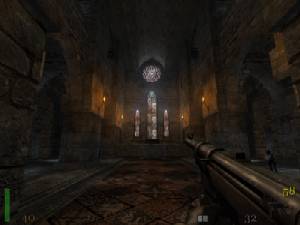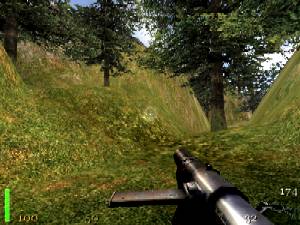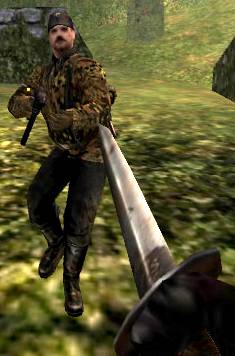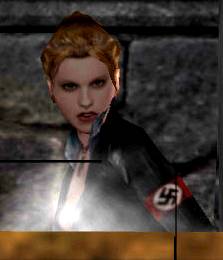
Date: January 14, 2002
If Doom is the father of
the First Person Shooter genre, then Wolfenstein is the spiritual grandfather.
It is the game that served as the primary inspiration for its more
technologically advanced rival, and a game that definitely served up some
incredible game play fun. Though multiplayer was unknown in those days, who can
forget the ominous laughter of machine-gun wielding SS guards, the deadly
clanking of Hitler’s mechanical battle suit, or the mechanical whir of
industrial-strength doors opening and shutting?
Return to Castle Wolfenstein has been hotly anticipated since it was announced.
It’s a fact, of course, that most sequels don’t live up to the stories that
inspired them, but debate ran hot on this one. Surely they wouldn’t allow one of
their oldest franchises to be butchered, would they? The game is finally here
and the news for the most part is great—but not entirely.
Technical Excellence
One place where RtCW absolutely amazes is in the sound and graphics department.
Bullets make different sounds depending on what surface they impact and every
weapon has its own unique tone, from the high crack of the Lugar to the feathery
‘whoosh’ of the flamethrower. The Tesla gun crackles and spits while the
Thompson has its own low cough that’s completely different from the other
automatic weapons. The music is also absolutely excellent and serves to add
tremendously to the game. It’s a good thing it adds so much, because
unfortunately there aren’t a great many musical themes. expect to listen to the
same three or four pieces throughout the single-player experience. Still this
isn’t much more than an annoyance - aurally, this game is just that good.
The visuals of Wolf are just as good. If you’re looking for a game that would
justify that GeForce3 purchase, this is definitely it. The game makes great use
of lighting and shadow, while textures and outside environments look every bit
as good. If you’re crawling through a lush forest, rest assured, it looks
forest-ish,  while the dank
walls of a castle or gray metal of an army base are all just as extensively
detailed. Muzzle flashes and weapon effects are extremely well done and the game
features the best flame and lightning effects (attached to the flamethrower and
Tesla Coil respectively) that I’ve ever seen.
while the dank
walls of a castle or gray metal of an army base are all just as extensively
detailed. Muzzle flashes and weapon effects are extremely well done and the game
features the best flame and lightning effects (attached to the flamethrower and
Tesla Coil respectively) that I’ve ever seen.
Enemy models look great and are built using a mix-n-match system that allow for
over 160 subtly different combinations and different types of foes. The AI is
equally as good, as troops will engage, retreat, attack from cover, and in one
of the coolest displays of programming I’ve seen yet, arrive on the scene and
wait in ambush. At one point in the game a grunt arrived just in time to see mE
toast two or three of his comrades. Rather than charging forward himself or
dodging and rolling he hid behind a wall and waited until I passed by, then shot
me from behind. Fabulously done.
In other departures from games today (though this one shouldn’t be) Wolf is
stable. Yes, Virginia, games CAN be stable in a 1.0 release. I encountered NO
crashes or sudden departures back to the desktop, even (purposefully) receiving
an IM and getting bounced to desktop allowed me to continue my game without
incident. This is a marvelous ‘feature’ in a game and one that ALL developers
should implement.
Choose Your Weapon
The weapon load out in Wolf is quite varied as well and ranges from pistols to
advanced rocketry. Although Wolf does allow for BJ to lug five or six massive
machine guns around simultaneously, access to the game’s weapons tends to be
varied far more by ammo type than by power of the weapon. We appear to finally
be moving away from the idea that more powerful weapons always become available
in the end-game alone. In Wolfenstein all of the weapons with the exception of
the Tesla Coil appear relatively early, but finding ammo for them is another
matter.
Wolf’s weaponry feels very well balanced in single player, with various weapons
having very different rates of fire, reload, and accuracy. The Thompson is a
highly accurate and deadly submachine gun, but ammo for it is rare unlike the
plentiful but inaccurate MP40 (obviously the weapon design stormtrooper rifles
were modeled after it. ;) )
From grenades to Panzerfausts (rockets) Wolf’s weapons feel excellent and their
graphics are top-notch as well.
Sounds Great, But Will It
Run?
With any game as technologically advanced as RtCW, there’s always a very valid
question of system compatibility. Most gamers are in for a treat here as well,
however, as the developers of Wolfenstein have made sure the game will run on a
variety of system configurations. Any video card from the original GeForce on up
should be able to run the game, but only owners of at least GeForce2 GTS’s are
going to be able to experience it in its full glory—at least consistently.
 My
Voodoo5 was capable of running the game in 32-bit color, 800x600 at a smooth
frame rate with texture detail turned to High during most of the game, but
during the outdoor settings the Quake 3 engine (or at least this version of it)
really chugs.
My
Voodoo5 was capable of running the game in 32-bit color, 800x600 at a smooth
frame rate with texture detail turned to High during most of the game, but
during the outdoor settings the Quake 3 engine (or at least this version of it)
really chugs.
I was forced to lower texture detail to
minimum and texture quality to 16-bit in order to run the game smoothly in the
large outdoor expanses. Clearly the Q3A engine wasn’t intended to render such
large areas as the game ran quite smoothly with a much higher detail level in
the more confined areas and tunnels.
It’s a tribute to the designers of the game that it looks as good as it does
even running at below maximum visual levels. Even with 32-bit textures turned
off, Wolfenstein amazes graphically.
Single-player: The
Parts are Greater than the Whole or Return to Castle NOLFenstein
Having covered Wolf’s amazing technical feats, the next question, of course, is
how does it play? Here’s where things get a bit muddled.
 One minor but important
nitpick—the German speaking guards are gone. This is criminal. No more cries of
“Mein Leben” or “Achtung!” Not a major flaw, but the German would’ve made for a
more immersive game and some old school killing Nazi goodness.
One minor but important
nitpick—the German speaking guards are gone. This is criminal. No more cries of
“Mein Leben” or “Achtung!” Not a major flaw, but the German would’ve made for a
more immersive game and some old school killing Nazi goodness.
One thing I immediately noticed is how Wolfenstein feels similar to last year’s
No One Lives Forever. As in NOLF, the guards in Wolf will often run around
and/or say little phrases when they know you are in the area—in fact, at one
point I could swear I heard one of the voice actors in both games. Another area
in which NOLF and Wolf are similar is in mission design. Many missions of NOLF
have Kate Archer sneaking around the mountains or villages with her mission
instantly over if detected. This is a game device Wolf uses on more than one
occasion. Nothing wrong with that—it is more realistic—but it also makes the
game feel a bit less Wolfenstein-ish. The original BJ wasn’t about sneaking
around and knifing Nazi’s in the back so much as he was about whipping out two
tons of firepower and letting loose. Getting detected might mean that
four-hundred Nazi’s were going to come pouring out of the nearby barracks, but
it never meant the automatic end of a mission.
Both RtCW and NOLF also feature long, story-driven cut-scenes. This works well
in NOLF, where the voice actors are engaging. The cut-scenes themselves
relatively funny, and the player is given some control over dialogue choices. In
Wolf they work badly—the cut scenes are long, but the voice actors are neither
particularly great nor funny, and most of the dialogue is delivered in
monotones. No player input is ever given—in fact, BJ Blakowitz himself is only
seen once or twice in the entire game and never speaks.
In NOLF, the length and depth of the cut-scenes matched the length and depth of
the story itself, and the game took you to dozens of locations, from Morocco to
outer-space. The creators of Wolf definitely attempt to build an intricate and
detailed plot involving Nazi High Priestesses, undead demons, super soldiers,
and the Occult, but the game itself is too short to allow all of these
components to be adequately detailed and fleshed out. Rather than shooting for
such lofty goals and detailed plots, the designers would’ve done better to pick
a shorter, more intense, and action-filled game whose ten hours of play time,
though short, would grab the gamer in a death-grip.
It’s not that the plot of Wolf is bad—it’s just that it feels incomplete and
sparsely populated. Either a longer single-player campaign or a shorter, tighter
plot would’ve gone a long way to fixing this problem and giving the game a
better sense of overarching coherency.
Fabulous Mission Design
If the overall plot of Wolf feels weak, however, the individual missions more
than make up for it. The missions themselves range from the titular escape from
Castle Wolfenstein to stealing a theoretical rocket jet and sneaking into a
German-fortified town. The missions are tightly focused, gripping, and
fabulously well done. In this regard, RtCW succeeds more when taken on a
mission-by-mission viewpoint than when focusing on the entire plot. Only when I
finished the game did I look back and notice the connecting weaknesses -
in-game, I was far too concerned with staying alive and not getting set on fire
by the Nazi flamethrowers….
Multiplay
Multiplay in RtCW is an intriguing mix of ‘Assault’ from Unreal Tournament and
the venerable ‘Team Fortress’ of Quake and Half-Life fame. In it, a player picks
a side (Axis or Allies), a role ‘Soldier, Medic, Lieutenant, or Engineer’, and
his/her choice of primary weapon. All the weapons from the game are available,
but a piece's usefulness shifts depending on the map selected and all of them
carry various penalties for weight and agility. Once sides and loadouts are
selected, the two teams compete back and forth for control of objectives while a
set timer counts down the map.

One of the interesting facets of Wolf multiplay is that players no longer
instantly re-spawn after a frag. Rather, upon dying the player is inserted into
a queue and everyone that has died in the last 30 seconds is refreshed
simultaneously. This innovation adds to a more team-oriented sense of gameplay
as everyone is charging out of the bunker at once—not dribbling out in one’s and
two’s.
Multiplay in Wolfenstein is, in so many words, a LOT of fun. It's an innovative,
interesting, and surprisingly thought-provoking mode that requires players to
strategize and work together in order to succeed in a mission. The
mission-oriented structure itself also keeps the game alive and interesting and
there are usually two or three ways to approach a choke point or objective,
ensuring the game doesn’t get too old.
Conclusion: Great
Game—but is it a sequel?
At the end of the day, my biggest complaint about Return to Castle Wolfenstein
is that it just doesn’t feel much like a sequel. While it’s a technically
beautiful and stable product with great individual missions and an addictive
multiplayer mode, it just doesn’t feel very much like Wolfenstein—more like
WolfenNOLF. There’s nothing wrong with copying a design that works, and I highly
recommend NOLF to the three people out there that haven’t played it, but in this
case I can’t help feeling a little let down. While RtCW succeeds well on its own
merits, it doesn’t feel like much of a continuation of the Wolfenstein
‘universe’.
Pros
• Great graphics and sound
• Excellent multiplayer
• Good weapon balance and selection
• Intriguing and gripping missions.
Cons
• No German speaking guards
• Weakly linked over-arching plot
• Doesn’t feel all that much like a Wolfenstein sequel
===================================
Pssst! We've updated our Shopping Page.
===================================